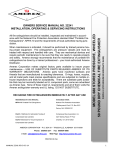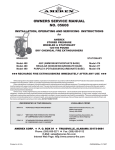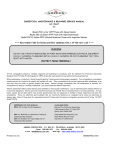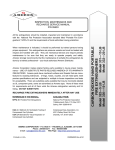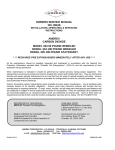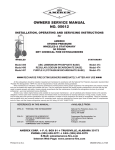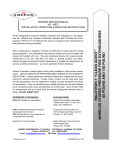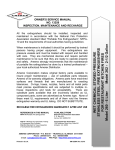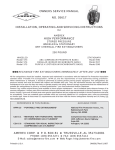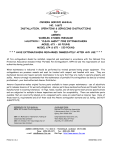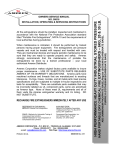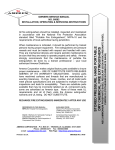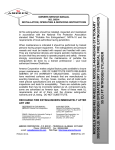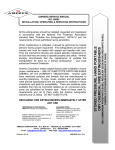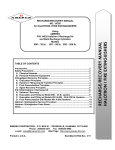Download Manual for 50 lb. stored pressure wheeled
Transcript
When maintenance is indicated, it should be performed by trained persons having proper equipment. Fire extinguishers are pressure vessels and must be treated with respect and handled with care. They are mechanical devices and require periodic maintenance to be sure that they are ready to operate properly and safely. Amerex strongly recommends that the maintenance of portable fire extinguishers be done by a trained professional – your local authorized Amerex Distributor. Amerex Corporation makes original factory parts available to insure proper maintenance – USE OF SUBSTITUTE PARTS RELEASES AMEREX OF ITS WARRANTY OBLIGATIONS. Amerex parts have machined surfaces and threads that are manufactured to exacting tolerances. O-rings, hoses, nozzles, and all metal parts meet precise specifications and are subjected to multiple in-house inspections and tests for acceptability. There are substitute parts available that may be incorrectly labeled as UL component parts, some are advertised as Amerex type. None of these meet UL requirements and all of them voids the Amerex extinguisher warranty and UL listing. DO NOT SUBSTITUTE. RECHARGE FIRE EXTINGUISHERS IMMEDIATELY AFTER ANY USE REFERENCES IN THIS MANUAL: NFPA-10 Portable Fire Extinguishers AVAILABLE FROM: National Fire Protection Association 1 Batterymarch Park, P.O, Box 9101 Quincy, MA 02269-9101 CGA C-1 Methods for Hydrostatic Testing of Compressed Gas Cylinders CGA C-6 Standard for Visual Inspection of Compressed Gas Cylinders Compressed Gas Association, Inc. 4221 Walney Road, 5th Floor Chantilly, VA 20151-2923 AMEREX CORPORATION – P.O. BOX 81 – TRUSSVILLE, ALABAMA 35173-0081 Phone: 205/655-3271 Fax: 800/654-5980 e-mail: [email protected] Web Page: http://www.amerex-fire.com Printed in U.S.A. 0M05612E Rev. 08/10 ABC (AMMONIUM PHOSPHATE BASE), REGULAR (SODIUM BICARBONATE BASE), PURPLE K (POTASSIUM BICARBONATE BASE) All fire extinguishers should be installed, inspected and maintained in accordance with the National Fire Protection Association standard titled "Portable Fire Extinguishers", NFPA-10 and the requirements of local authorities having jurisdiction. STORED PRESSURE, WHEELED & STATIONARY 50 POUND DRY CHEMICAL FIRE EXTINGUISHERS OWNERS SERVICE MANUAL NO. 05612 INSTALLATION, OPERATING & SERVICING INSTRUCTIONS THIS MANUAL IS ATTACHED TO EVERY NEW EXTINGUISHER SHIPPED FROM THE FACTORY. IT CONTAINS VALUABLE INFORMATION WHICH SHOULD BE STUDIED BY EVERYONE WHO WILL USE OR SERVICE THE EXTINGUISHER. THE MANUAL SHOULD BE STORED IN A CONVENIENT LOCATION FOR EASY REFERENCE. INTRODUCTION The Amerex 50 pound Models 495 (ABC), 496 (Regular) & 497 (Purple K) Stored Pressure Wheeled and Models 473 (ABC), 474 (Regular) & 475 (Purple K) Stationary Dry Chemical fire extinguishers are designed to provide larger volumes of dry chemical fire fighting agent than hand portable types for industrial applications. The wheeled version can easily be transported and operated by one person and in a stationary configuration and can be mounted in a small space. The cage type carriage provides protection for the operating valve, cylinder and hose assembly. Easy rolling 12 ½ inch semi-pneumatic rubber tires assure minimum effort to quickly transport them through narrow spaces to a fire scene. An easy to operate "T" handle assures "instant on" extinguisher discharge. All valve components, hose couplings and nozzle shut-off are machined brass for easy maintenance. A quality paint finish tops off a prime coated cylinder and carriage assembly for years of trouble free use. These models carry an Amerex warranty of six years – see full wording of the warranty below. Field recharging is possible utilizing maintenance/recharge equipment available through your Amerex Distributor. To provide optimum extinguisher reliability, recharging should be performed by persons trained in fire extinguisher maintenance and servicing. This manual should be used as a guide for installing, operating and servicing this extinguisher. The best place to have your extinguisher serviced and recharged is your Authorized Amerex Distributor who has the professional experience and equipment to do it properly. SIX YEAR LIMITED WARRANTY Amerex warrants its fire extinguishers to be free from defects in material and workmanship for a period of six (6) years from the date of purchase. During the warranty period, any such defects will be repaired or the defective extinguisher replaced if only factory replacement parts and recommended service equipment have been used to service the extinguisher. This warranty does not cover defects resulting from modification, alteration, misuse, exposure to unusually corrosive conditions nor improper installation or maintenance. All implied warranties, including, but not limited to, warranties of fitness for purpose and merchantability, are limited to the time periods as stated above. In no event shall Amerex Corp. be liable for incidental or consequential damages. Some states do not allow limitations on how long an implied warranty lasts or the exclusion or limitation of incidental or consequential damages, so that the above limitations or exclusions may not apply to you. Amerex Corp. neither assumes nor authorizes any representative or other person to assume for it any obligation or liability other than expressly set forth herein. This warranty gives you specific legal rights, and you may also have other rights which may vary from state to state. To obtain performance of the obligation of this warranty, write to Amerex Corp., P. O. Box 81, Trussville, AL 35173-0081 for instructions. 1 AMEREX CORPORATION DOES NOT SERVICE, MAINTAIN OR RECHARGE FIRE EXTINGUISHERS. THIS MANUAL IS PUBLISHED AS A GUIDE TO ASSIST QUALIFIED SERVICE PERSONNEL IN THE INSPECTION, MAINTENANCE AND RECHARGE OF AMEREX FIRE EXTINGUISHERS ONLY. NO INSTRUCTION MANUAL CAN ANTICIPATE ALL POSSIBLE MALFUNCTIONS THAT MAY BE ENCOUNTERED IN THE SERVICE OF FIRE EXTINGUISHERS. DUE TO THE POSSIBILITY THAT PRIOR SERVICE PERFORMED ON THIS EQUIPMENT MAY HAVE BEEN IMPROPERLY DONE, IT IS EXTREMELY IMPORTANT THAT ALL WARNINGS, CAUTIONS AND NOTES IN THIS MANUAL BE CAREFULLY OBSERVED. FAILURE TO HEED THESE INSTRUCTIONS COULD RESULT IN SERIOUS INJURY. AMEREX ASSUMES NO LIABILITY FOR SERVICE, MAINTENANCE OR RECHARGE OF FIRE EXTINGUISHERS BY PUBLISHING THIS MANUAL. PREPARING YOUR NEW EXTINGUISHER FOR USE 1. Examine the extinguisher for evidence of shipping damage. Notify the delivering carrier immediately if any damage is discovered. 2. Remove all wrappings, straps and pallet retaining bolts. 3. Check to insure that the hose connection to the operating valve and shut-off nozzle to the hose are tight. 4. Check to insure that the shut-off nozzle is in the closed position. The ring (safety) pin should be installed in the operating valve and the lockwire (tamper) seal intact. 5. This extinguisher is shipped from the factory fully charged. Visually inspect the pressure gauge – the pressure should be in the green zone (240 psi ± approx. 10 psi range). The most accurate method to determine if the extinguisher is filled with the proper amount of chemical is to weigh the unit. The gross weight is indicated on the nameplate (label). NOTE: Slight pressure variances in the gauge reading may be found if the extinguisher has been subjected to extremes of heat or cold. High temperatures can cause high gauge readings and low temperatures, low readings. When in doubt, condition the extinguisher to 70ºF (21ºC) for several hours to obtain more accurate pressure gauge readings. 6. Record the date the unit is being placed into service on the inspection tag and attach it to the extinguisher. INSTALLATION Do not place this extinguisher close to a potential fire hazard. Amerex recommends location no less than a 50 foot distance from the hazard while leaving an unobstructed access. Avoid placing it in an extremely hot or cold place. The operational temperature range for this extinguisher is -40ºF to +120ºF (-40ºC to +49ºC). The extinguisher should be adequately protected if temperatures outside of this range are anticipated. Keep the extinguisher clean and free from dirt, ice, chemicals and any contaminants which may interfere with its proper operation. Do not functionally test this fire extinguisher. (Testing or any use may cause the extinguisher to gradually lose pressure and become ineffective.) 2 OPERATION NOTE: Persons expected to use this extinguisher should be trained in initiating its operation and in the proper fire fighting technique. Familiarize all personnel with this information before an emergency occurs. 1. Move the extinguisher to within approximately 30 feet of the fire site. Keep the extinguisher upright. CAUTION: This extinguisher must be operated in an upright position. If equipped with an optional tow loop and vehicle towed to the fire scene, remove from tow hitch and operate in a vertical position. 2. Twist and pull ring pin. Open cylinder discharge valve by rotating (pulling) the "T" handle valve lever toward the hose. The hose is now pressurized with chemical. 3. Pull nozzle, with lever in the closed position, from the mount and extend the hose from the storage rack. 4. Stand back 15 feet from the fire and aim the nozzle at base of flames nearest you. Open nozzle by pulling handle toward you (be prepared for a discharge recoil by holding the nozzle firmly). 5. Sweep side to side across the base of the fire and past both edges. Progressively follow up until the fire is extinguished. Work the fire away from you while being alert for flashbacks. Move closer as the fire is extinguished but not so close as to scatter or splash the burning materials. 6. When the fire is out, push the nozzle lever forward to the closed position. Push the "T" handle on the cylinder discharge valve to the closed position. 7. Evacuate and ventilate the area immediately after extinguishing the fire. The fumes and smoke from any fire may be hazardous and can be deadly. DISCHARGE TIME – 35 SECONDS (APPROXIMATELY) EFFECTIVE RANGE OF AGENT THROW IS 25 TO 30 FEET HOSE LENGTH – 25 FEET SHUTDOWN CAUTION: BEFORE PERFORMING THE SHUTDOWN PROCEDURE AND PREPARING TO MOVE THE EXTINGUISHER TO THE RECHARGE LOCATION, DETERMINATION MUST BE MADE THAT THE FIRE IS COMPLETELY EXTINGUISHED AND THERE IS NO DANGER OF A FLASHBACK. 1. Tip the extinguisher to the horizontal position (resting on the carriage handle) and slowly push the "T" handle on the cylinder discharge valve to the open position. Slowly push the nozzle lever to the open position and be prepared for some chemical discharge. 2. When all pressure has been evacuated from the extinguisher, return the nozzle lever and cylinder discharge valve to the closed position. NOTE: These steps will allow easy depressurization of the extinguisher and clear the hose assembly with a minimal loss of remaining chemical. 3. Return the extinguisher to the upright position. Coil the hose onto the storage rack and position the nozzle into the mount in preparation for transport to the recharge location. RECHARGE EXTINGUISHERS IMMEDIATELY AFTER ANY USE 3 INSPECTING THE EXTINGUISHER This extinguisher should be inspected at regular intervals (monthly or more often if circumstances dictate) to insure that it is ready for use. Inspection is a "quick check" that a fire extinguisher is available and is in operating condition. It is intended to give reasonable assurance that the fire extinguisher is fully charged. This is done by verifying that it is in its designated place, that it has not been actuated or tampered with, and that there is no obvious physical damage or condition to prevent its operation. PERIODIC INSPECTION PROCEDURES (Monthly or more often if circumstances dictate) [NFPA-10] Periodic inspection of fire extinguishers shall include a check of at least the following items: 1. 2. 3. 4. 5. 6. 7. Location in designated place. No obstruction to access or visibility. Pressure gauge reading or indicator in the operable range or position. Operating instructions on nameplate and facing outward. Safety seals and tamper indicators not broken or missing. Examination for obvious physical damage, corrosion, leakage, or clogged nozzle. Determine fullness by weighing. MAINTENANCE [NFPA-10] At least once a year or more frequently if circumstances require, maintenance should be performed. Maintenance is a "thorough check" of the extinguisher. It is intended to give maximum assurance that a fire extinguisher will operate effectively and safely. It includes a thorough examination for physical damage or condition to prevent its operation and any necessary repair or replacement. It will normally reveal if hydrostatic testing or internal maintenance is required. MAINTENANCE – SERVICE PROCEDURE NOTE: 1. THIS PROCEDURE WILL BE BEST ACCOMPLISHED WITH THE EXTINGUISHER IN AN UPRIGHT POSITION AND ON A LEVEL SURFACE. Clean extinguisher to remove dirt, grease or foreign material. Check to make sure that the instruction nameplate is securely fastened and legible. Inspect the cylinders for corrosion, abrasion, dents or weld damage. If any damage is found, hydrostatically test to factory test pressure 480 psi (3310 kPa), using the proof pressure method, in accordance with instructions in C-6 and NFPA 10. See proper method of depressurizing and reclaiming chemical in Recharge procedures. NOTE: WHEN CLEANING, AVOID USE OF SOLVENTS AROUND THE PRESSURE GAUGE. THEY COULD SERIOUSLY DAMAGE THE PLASTIC GAUGE FACE. 2. Inspect the extinguisher for damaged, missing or substitute parts. Only factory replacement parts are approved for use on Amerex fire extinguishers. 3. Weigh the extinguisher and compare with weight printed in the "Maintenance" section on the nameplate (label). Recharge extinguisher if weight is not within indicated allowable tolerances. 4 4. Check the date of manufacture printed on the extinguisher label (nameplate) or on the agent cylinder dome. The agent cylinder must be hydrostatically tested every 12 years to the test pressure indicated on the nameplate 480 psi (3310 kPa). 5. Visually inspect the pressure gauge: a. If bent, damaged or improper gauge, depressurize and replace. b. If pressure is low, check for leaks. c. If over pressurized (overcharged), depressurize the extinguisher and follow recharge instructions. 6. Check ring pin for freedom of movement. Replace if bent or if removal appears difficult. 7. WARNING: ALWAYS OPEN THE SHUTOFF NOZZLE HANDLE SLOWLY. ANY EVIDENCE OF AGENT IN THE NOZZLE INDICATES THAT THE UNIT MAY HAVE BEEN USED AND THE USE NOT REPORTED. BE PREPARED FOR A POSSIBLE DISCHARGE AND NOZZLE RECOIL. Check the nozzle shutoff lever for freedom of movement (open and close several times). If the operation is impeded, disassemble the nozzle, replace parts and/or properly lubricate as necessary. Make sure that the nozzle tip is clear and unobstructed. 8. After making sure that there is no residual pressure in the discharge hose, disconnect it from the operating valve. Blow air through the hose and nozzle assemblies to insure that the passage is clear of foreign material. Check the couplings, hose and hose gasket for damage or deterioration – replace as necessary. 9. Inspect the valve assembly for corrosion or damage to hose thread connection. Replace valve assembly or component parts as necessary following the proper depressurization and recharge procedures. If valve removal is necessary, complete all steps in the Recharge Procedure. 10. Reconnect the hose to the agent cylinder. Properly coil the hose on the rack and install the nozzle (with the lever in a closed position) on the mount. NOTE: WHEN ASSEMBLING THE HOSE TO THE AGENT CYLINDER OR NOZZLE TO THE HOSE, TIGHTEN THE COUPLING ¼ TURN AFTER CONTACTING THE HOSE GASKET. 11. Inspect the wheels on Models 495, 496 or 497 to insure they rotate freely. Lubricate as required. On stationary models, check mountings to insure that they are securely fastened. 12. Check carriage assembly for loose nuts, bolts, frame distortion or damage. Check welds for damage or corrosion. Replace damaged parts or make repairs as necessary. 13. Install new lockwire (tamper) seal and record service data on the extinguisher inspection tag. 14. If the extinguisher has been moved to perform service, make sure that it is returned to its proper location. 5 COMPLETE MAINTENANCE – SIX YEAR TEARDOWN [NFPA-10] Every six years, stored pressure extinguishers that require a 12 year hydrostatic test shall be emptied and subjected to the applicable maintenance procedures. When the applicable maintenance procedures are performed during periodic recharging or hydrostatic testing, the six year requirement shall begin from that date. NOTE: Some states have legislation which requires "Complete Maintenance" on an annual basis. Please contact your local Amerex Distributor to see if these requirements apply to you. NFPA 10 recommendation requires that a "verification of service" external collar tag be installed on the extinguisher whenever a Six Year Maintenance is performed. The "verification of service" tag can only be installed if the operating valve has been removed. 1. Discharge chemical and pressure into a "closed" dry chemical recovery system (several are commercially available). depressurized. NOTE: Make sure that the extinguisher is completely empty and A "closed recovery system" is designed to prevent loss of the chemical "fines". Loss of the "fines" could result in reduced extinguisher efficiency. 2. Clean extinguisher to remove dirt, grease or foreign material. Check to make sure that the instruction nameplate is securely fastened and legible. Inspect the cylinder for corrosion, abrasion, dents or weld damage. If any of these conditions are found and you doubt the integrity of the cylinder, hydrostatically test to factory test pressure marked on the nameplate (label), using the proof pressure method, in accordance with CGA C-1 and NFPA 10. NOTE: When cleaning, avoid use of solvents around the pressure gauge. They could seriously damage the plastic gauge face. 3. Inspect the extinguisher for damaged, missing or substitute parts. Only factory replacement parts are approved for use on Amerex fire extinguishers. 4. Check the date of manufacture on the extinguisher label (nameplate). Cylinder must be hydrostatically (proof pressure) tested every 12 years to the test pressure indicated on the nameplate (480 psi [3310 kPa]). 5. Visually inspect the pressure gauge – if bent, damaged or improper gauge replace with the proper Amerex pressure gauge (see Parts List). 6. Check ring pin for freedom of movement. Replace if bent or if removal appears difficult. 7. Verify that no pressure remains in the extinguisher. (Operating valve and nozzle shutoff in open position and there is no discharge). 8. Check the nozzle shutoff lever for freedom of movement (open and close several times). If the operation is impeded, disassemble the nozzle, replace parts and/or properly lubricate as necessary. Make sure that the nozzle tip is clear and unobstructed. 9. Disconnect the discharge hose from the operating valve. Blow air through the hose and nozzle assemblies to insure that the passage is clear of foreign m ateria l. Check the couplings, hose and hose gasket for damage or deterioration – replace as necessary. The discharge hose should be hydrostatically tested to 480 psi (3310 kPa) every twelve years. 10. Inspect the wheels to insure they rotate freely. Lubricate as required. 6 11. Check carriage assembly for loose nuts, bolts, frame distortion or damage. Check welds for damage or corrosion. Replace damaged parts or make repairs as necessary. WARNING: Valve removal and/or valve part replacement should be made only after completing the depressurizing procedures listed in Step 1 of the Complete Maintenance section. 12. Remove operating valve assembly. Inspect for corrosion or damage to hose thread connection. 13. Complete steps 2 through 14 of Recharge Procedure. RECHARGE WARNING: a. Before attempting to disassemble, be sure the extinguisher is completely depressurized. b. Never have any part of your body over the extinguisher while removing the valve assembly. c. Use a protective shield between you and the pressure gauge while charging an extinguisher. Do not stand in front of the gauge if a shield is not available. d. Use a regulated pressurizing source of dry nitrogen only with a minimum dew point of minus 70ºF (minus 57ºC). Set the regulator to no more than 265 psi (1827 kPa). e. Check and calibrate regulator gauge at frequent intervals. The regulator gauge should be used to determine when the intended charging pressure has been reached. Do not use the extinguisher gauge for this purpose. f. Never leave an extinguisher connected to a regulator of a high pressure source for an extended period of time. A defective regulator could cause the cylinder to rupture due to excessive pressure. g. Do not mix types of dry chemicals in extinguishers, recharge or recovery systems. Mixing ABC (acidic base) with Regular, Purple-K, Super-K or Monnex (alkaline base) dry chemicals may result in a chemical reaction capable of developing a dangerous pressure buildup. RECHARGING PROCEDURE 1. Perform steps 1 through 12 of the "Complete Maintenance (Six Year Teardown)" section. 2. Thoroughly clean all parts of the disassembled valve with a soft bristle brush or soft cloth. Blow the valve out with air or nitrogen. Inspect the collar o-ring, spring and downtube assembly, and replace parts if worn or damaged. Replace the valve stem. Lubricate the collar o-ring and small o-ring on the valve stem with Visilox V-711 (do not lubricate the valve stem seal). 3. Reassemble the valve assembly, including downtube and set aside. 4. Remove any chemical remaining in the cylinder and check the condition. Properly dispose of any chemical that is contaminated or caked. 5. Inspect the cylinder interior following CGA Visual Inspection Standard C-6. 6. Using an accurate scale, fill cylinder with the correct amount and type of dry chemical specified on the label (nameplate). Use Amerex chemical which has been kept free of moisture and contamination. See Warning (g) – DO NOT MIX TYPES OF CHEMICALS. 7. Clean cylinder collar o-ring seat and collar threads with a small brush and then wipe off surfaces with a clean cloth to remove dust. Lightly brush the collar o-ring seat with Visilox V-711. 7 8. Install "verification of service" external collar tag. Install discharge valve assembly and attach pressurizing adapter (P/N 06160) to discharge port. 9. Pressurize extinguisher with dry nitrogen to 240 psi. Nitrogen supply regulator should be set to no more than 265 psi. This will insure proper aeration of the chemical. 10. Check extinguisher for leaks by applying detecting fluid or a solution of soapy water to the nitrogen charging adapter orifice, around the collar o-ring sealing area, cylinder welds and gauge. Remove the pressurizing adapter. 11. Install discharge hose and discharge nozzle assembly (see instructions). 12. Install ring (safety) pin and lockwire (tamper) seal. Attach new recharge tag. 13. Return extinguisher to its proper location. Mountings for stationary extinguishers should be properly secured. TROUBLESHOOTING GUIDE WARNING: Before attempting to correct any leakage problem, be sure that the agent cylinder and hose are completely depressurized. Check to determine the source of a leak before the extinguisher is depressurized. Leakage repairs will require depressurization and removal of the valve assembly. Depressurize by discharging into a Closed Recovery System or inverting the extinguisher. After depressurizing the extinguisher and correcting the problem, it will be necessary to clean all valve parts thoroughly. PROBLEM CORRECTIVE ACTION 1. Leak at collar o-ring Remove valve assembly, remove and discard o-ring, clean collar and lube lightly with Visilox V-711. Clean o-ring groove on valve and install new collar o-ring. Lubricate with Visilox V-711. 2. Leak through valve Check valve stem seating area for scratches or foreign matter. Clean seating area with a tooth brush and soft cloth. Install new valve stem assembly. 3. Leak around gauge Remove gauge*, clean threads and reinstall using Teflon tape on the gauge threads. 4. Defective gauge Remove defective gauge* an install the proper Amerex pressure gauge (P/N 05225 240 psi) using Teflon tape on the gauge threads. 5. Leak in the cylinder Contact Amerex if under warranty, otherwise mark "REJECTED" and remove from service or return to owner. * Pressure gauge threads are coated with a special epoxy at the factory. For easy removal, soak the valve assembly in hot water (180°F) for two to four minutes. Remove gauge with a thin 7/16" open end wrench. 8 Connect hose coupling to outlet on the extinguisher. Lay hose straight on ground to its full 25 ft. length. Start first regular loop counterclockwise by placing between side brackets and over the top bracket. 2 The second loop is a REVERSE loop. Notice that the hose passes behind the loop on this reverse loop. If instructions are followed, the hose will uncoil without kinks. 3 The next loop is a regular "hose in front" loop. Succeeding loops are alternated: reverse, front, reverse, etc. for six full loops. 4 Adjust the loops so that the nozzle fits into the nozzle mount. Loops should be approximately the same size. Guide to Proper Installation of Hose on 50 lb. Wheeled or Stationary Dry Chemical Fire Extinguishers 1 9 PARTS LIST for 50 lb. Wheeled Stored Pressure Dry Chemical Extinguishers 473 474 475 Item No. Part No. 1 2 3 06018 06072 06625 4 00155 5 06374 6 7 06375 06376 07480 07482 8 9 06377 10 11 12 13 14 15 04945 06373 06153 05225 06100 01387 05240 16 17 18 19 20A 20 21 22 23 24 06022 00383 07247 06056 06015 06397 06395 06396 06031 03877 06208 06032 06210 495 496 497 Description Std. Pkg. Valve Asy Complete w/Downtube Downtube/Retainer Assembly Carriage Assembly w/o Wheels Pressure Valve & Cap Assembly (Older Models Only) Hose Support w/Hardware, Hose Clip and Nozzle Mount Hose Clip w/Mounting Hardware Nozzle Mount w/Hardware Pictogram – Model 495, 473 1 1 1 12 1 1 1 1 Pictogram – Models 496, 497, 474, 475 Wheel Assembly 12 ½" w/Hub Cap, Washer & Retaining Pin Hub Cap Valve Lever ("T" Handle – Complete) Valve Body Gauge – 240 psi Ring Pin, Stainless Steel w/Wire Lockwire Seal (Yellow) Collar O-Ring Collar O-ring – Bulk Bag Valve Stem Assembly Spring Gasket, Hose Gasket, Valve Hose Assembly 25 ft. w/Gasket 1 1 1 1 1 12 500 24 100 6 6 6 6 1 Nozzle Asy (Ball Vlv & Tip) 495, 473 Nozzle Asy (Ball Vlv & Tip) 496, 474 Nozzle Asy (Ball Vlv & Tip) 497, 475 Ball Valve Assembly Gasket, Nozzle Nozzle Tip – 495, 473 (.328) Nozzle Tip – 496, 474 (.265) Nozzle Tip – 497, 475 (.281) 1 1 6 1 ALL FILL & HYDROTEST ADAPTERS – SEE ADAPTER PAGE REPLACEMENT VALVE ASSEMBLIES INCLUDE VALVE BODY, GAUGE, LEVER VLV STEM ASY, SPRING & HANDLE 10











